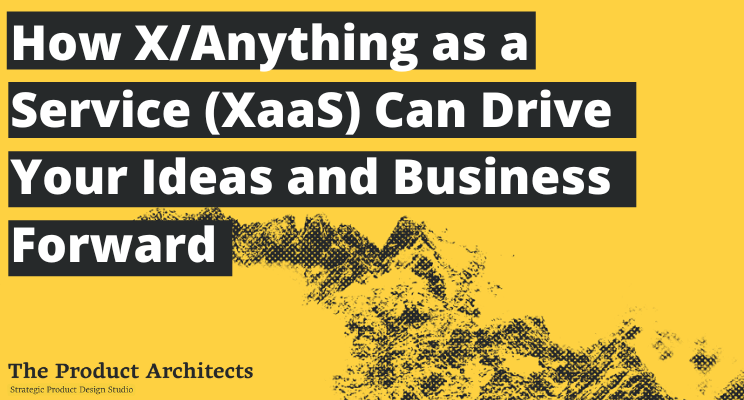
How X/Anything as a Service (XaaS) Can Drive Your Ideas and Business Forward
What is X/Anything as a Service (XaaS)?
Cloud computing and the internet has made all kinds of products easily accessible. Rather than going to a store to buy a physical product, many products can be purchased or obtained from a cloud platform. As our past need for physical products is now reduced or gone, product markets are evolving to accommodate. The solution to this change from a reliance on physical to digital products is XaaS.
Thanks to this service driven concept, a lot of products are now infinitely multipliable. Products are transformed from a single point of contact or sale to a continuous sale and customer communication channel. Although XaaS originated with software only, you can now really have anything as a service. From products, software and data to cars, communication, real life, online storage and more. Nonetheless, the focus in XaaS still lies heavily on digital solutions, something we are striving to change.
Examples of XaaS
· Adobe Creative Cloud – A suite of creative software and applications as a service.
· Azure or AWS – Microsoft or Amazon servers that offer a wide range of databases, infrastructure, online storage, communication services, etc., in a single and very scalable package.
· Car or bike sharing – A car or bike is available via platforms whenever you need it, but you don't need to bother about ownership. Poppy or Cambio are examples of two Belgian car sharing platforms.
· Lighting – Philips developed lighting fixtures specifically for Schiphol airport in Amsterdam. Schiphol rents light itself and Philips ensures that light bulbs and electricity are always available, improving the serviceability and lifetime of lighting fixtures.
Why is XaaS better than selling a product once?
Via XaaS, you can combat the infinite multiplication of a product and the manufacturer can ensure that as many people as possible can use the product. Maintaining ownership of the product also gives you more control over it and its related user experience. Furthermore, XaaS customers subscribe to a monthly subscription instead of buying a product once, which provides you with recurring revenue.
With XaaS, products have more flexibility, are very scalable and easily adaptable to current situations. It eliminates the risk of high first-time investments, which is a common customer barrier, and you can always consult external expertise when things go wrong.
Circularity
Next to the economic benefits are ecological ones. By providing a product but keeping its ownership within the company, products are naturally built to be strong and long lasting since this reduces costs in the long run. Even when a product breaks down, it is in the company's best interests to repair it, which produces less waste and encourages a circular economy.
As the product owner, you possess in-depth knowledge of its materials and construction method. You know which parts in a broken product are still reusable and how to break down non-repairable biodegradable parts so the land can regenerate it. In other words, you are aware of exactly what will happen to products and their parts that can no longer be used.
As awareness of sustainability and circularity grows, more and more consumers place importance and value on it. The result is that more companies are becoming sensitive about applying the circular economy system diagram, known as the butterfly diagram. The butterfly diagram distinguishes the two main cycles that keep products, materials and components in use at their highest value at all times. In the technical cycle (blue), non-biodegradable products, materials and components are kept in circulation for as long as possible. It's about maintaining and reusing these products to preserve its value and increase its usage length, then refurbishing, remanufacturing or recycling it when this is no longer possible to retain value. In the biological cycle, the strategy is to restore nutrients into the biosphere while rebuilding natural capital. These biodegradable materials are renewable by nature and can be cycled in biological cycles or cascaded to create further value for additional applications in different value streams (e.g. composting organic materials to extract valuable nutrients). Ultimately, a circular economy is about getting the most value from resources by keeping them at their highest utility and value.
How to design XaaS products
1. Start by considering the real value proposition you offer. Car companies offer the capability to go anywhere quite quickly, fridges offer a cool space to store food, sofas are a beautiful way or sitting in your living room, etc.
2. Look at the current ecosystem of your product on both the stakeholder and product level. Also look at the ecosystem before and after your product is sold, up until it is no longer usable and its components are either recycled or thrown away.
3. Identify where an intervention space exists and how you can intervene so that you're providing a service rather than selling the original product. See how you can close the loop between the "start" and "stop" of the product's usage.
4. Now search for possible product or service solutions that you can fit into this gap. Make sure to close the whole loop (ecological and economical) and keep resources within it as much as possible (butterfly diagram).
Although XaaS is typically associated with software products, literally anything can be offered as a service. XaaS products are more easily accessible for customers and offer owners a legion of benefits over traditional products. They're infinitely multipliable, provide recurring revenue, have more flexibility, scalability, circularity and reduce costs in the long run as they're built to last. If you need help with designing your next XaaS product or venturing into the world of XaaS, don't hesitate to get in touch with us.